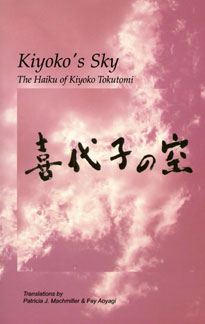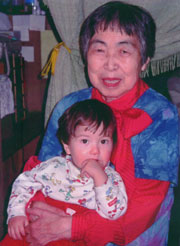Kiyoko's Sky:
|
|
|
Kiyoko Tokutomi. Kiyoko's Sky: The Haiku of Kiyoko Tokutomi © Nov. 2002. Perfect Bound, (5.5" X 8.5") 128 pages. ISBN: 1-929820-04-6 out of print Brooks Books is pleased to offer another dual language editions of haiku by the co-founder of the Yuki Teikei Haiku Society, Kiyoko Tokutomi.
"Kiyoko Tokutomi has been writing and teaching the writing of traditional Japanese haiku in Northern California for more than twenty-five years. This book gives us her delicately made haiku and reveals the devotion of her friends and students in the practice of yuki teikei. This is a very moving book and an unexpected bit of literary history." —Robert Hass, United States Poet Laureate (1995-1997) “One needs but take these verses to heart, to know the true spirit of haiku.” — James W. Hacket |
|
|
Kiyoko Tokutomi is one of those rare haiku poets who follow yuki teikei (the traditional Japanese form with a seasonal element or kigo) both in English and Japanese. To understand the background of her haiku, we should keep in mind that she lives in Ben Lomond, California, on the West Coast of the United States. I have heard that spring in California comes early, and by mid-February, many people have started wearing short-sleeved shirts. Cherry blossoms bloom in full in March or April, the same time as
in Japan. Around Ben Lomond communities even hold Cherry Blossom Festivals. The
summer in northern California is relatively cool along the coast. In
San Francisco, it seems that one needs an overcoat on a summer evening.
Though there is no lingering heat like in Japan, there are heat waves,
referred to as Indian summer, which come in September and October.
Winter is the rainy season, and especially around New Year, it rains
often. It is then that you can see a rainbow. Therefore, “rainy season” and “rainbow” would be winter kigothere.I have just described the physical and cultural landscape in which Kiyoko composes her haiku.
The key phrase, “between my fingers,” leaves us with the feeling that this is a sensitive woman.
The water of mid-winter is clear. Human beings become tense
physically and emotionally in the cold air. It makes one see
things better. We can picture the crisp, cold landscape.
Even in the beginning of the winter, the water has to be cold to make one’s fingers ache. —Shugyo Takaha |
|
|
|
Patricia J. Machmiller is a haiku writer who studied with Kiyoshi and Kiyoko Tokutomi, founders of the Yuki Teikei Haiku Society in San Jose, California. Patricia attributes her appreciation of haiku to her childhood in Kennebec, South Dakota, which was an instruction in simplicity in which she came to value the ordinary. She served as President of the Yuki Teikei Haiku Society from1978 to 1981; she co-edited with June Hopper Hymas Young Leaves: 25th Anniversary Issue of Haiku Journal; she and Jerry Ball write a regular column of haiku commentary, “Dojins’ Corner,” for GEPPO. Her own book of haiku, Blush of Winter Moon, is published by Jacaranda Press. |
Fay Aoyagi was born in Tokyo, Japan. She immigrated to the U.S. and after 10 years in New York City, she moved to San Francisco in 1995, where she started writing haiku and tanka in English. In 2000, she joined a Japanese haiku group Ten‘i. She supports her haiku life as a freelance interpreter. |

 About
the Author
About
the Author